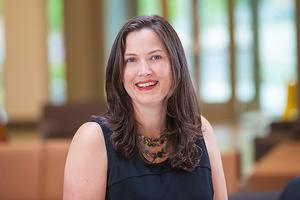Alumni
Public Health Law Professor: Three Things to Understand about COVID-19

As a professor specializing in public health law and ethics at American University Washington College of Law, Lindsay Wiley began tracking news about COVID-19 (coronarvirus) in early January. At AUWCL (currently ranked 11th for health care law by US News and World Report), Wiley is director of the Health Law and Policy Program, a nationally recognized destination for health law, policy and compliance studies. Wiley’s research focuses on access to health care and healthy living conditions in the US and globally.
At the start of her career, Wiley practiced law before earning a master’s in public health. Prior to joining AU, she worked for academic research institutes that focus on US and global health law.
As the AU community navigates the effects of the pandemic, Wiley shares her thoughts on a few key areas.
Front-line health workers need more protection.
Given their high levels of exposure to the virus, Wiley emphasizes, even young health workers with no underlying health conditions are highly vulnerable to severe illness and death and need proper protection. “Doctors, nurses, technicians, and support staff are reusing protective gear designed to be disposable and fashioning their own from craft store supplies and garbage bags,” she says. “We cannot expect them to take these risks and work without the protection they need to stay safe.”
People of color and people in low-income communities bear the brunt of the pandemic’s impacts.
“Because of long-standing structural inequalities and racism, people of color and people living in low-income communities are more likely to have asthma, diabetes, cardiovascular disease, and other underlying health conditions that put them at higher risk for severe illness and death from COVID-19. In addition, at a time when people are expected to spend as much time as possible alone in their homes, we must provide supports for people who are called on to put themselves at risk to meet our society’s essential needs for health care, food, and safety, those who don’t have safe and sanitary homes to shelter in, and those who are at risk of eviction or utility shut-off because so many are struggling with job loss,” Wiley explains. “Federal, state, and local governments are taking action to protect these communities from harm during the pandemic, but there’s much more to be done.”
Widespread testing is crucial.
A lack of widespread testing leaves scientific experts without enough data to advise elected officials in their response efforts. That’s why we’ve had to “resort to the most extreme social distancing measures in public health law—broadly applicable business shut-downs and stay-at-home orders, instead of a more targeted response informed by data.” But Wiley also says it’s not too late to turn things around. “With widespread testing, we’d be in a better position to anticipate where critical health care resources will be most needed with a month of time to plan, instead of a matter of days. Our public health and legal toolkits for combatting this pandemic depend heavily on testing and surveillance. Without it, cautious elected officials are forced to make the only safe assumption: that community transmission is equally widespread everywhere throughout the US. With [testing], however, we can learn more about how disease trends vary from place to place and time to time, allowing us to carefully ease and retighten restrictions and target our health care resources in response to good data during the 12–18 months we’ll likely have to wait for a safe and effective vaccine.”
Wiley also has a tip for staying informed—rely on the CDC (Centers for Disease Control and Prevention). “[T]he agency is full of hard-working scientists continuing to do great work. Their guidelines on community mitigation strategies in various settings, depending on the level of community transmission present in your area, will be a vital resource as we get a handle on what the level of community transmission is at various times in different parts of the country,” she says.
Like many others, Wiley is doing her part at home; she and her family stay in except for outdoor exercise and trips to get groceries every other week. “We’re also keeping close tabs on our mental wellbeing and supporting that for our kids.”
While the majority of the AU community is now online, Wiley remains aware that the university’s location in Washington, DC, still brings valuable connections to multiple levels of government. “[T]he relationships we’ve built in calmer times,” she says, “are allowing us to contribute to the response now.”